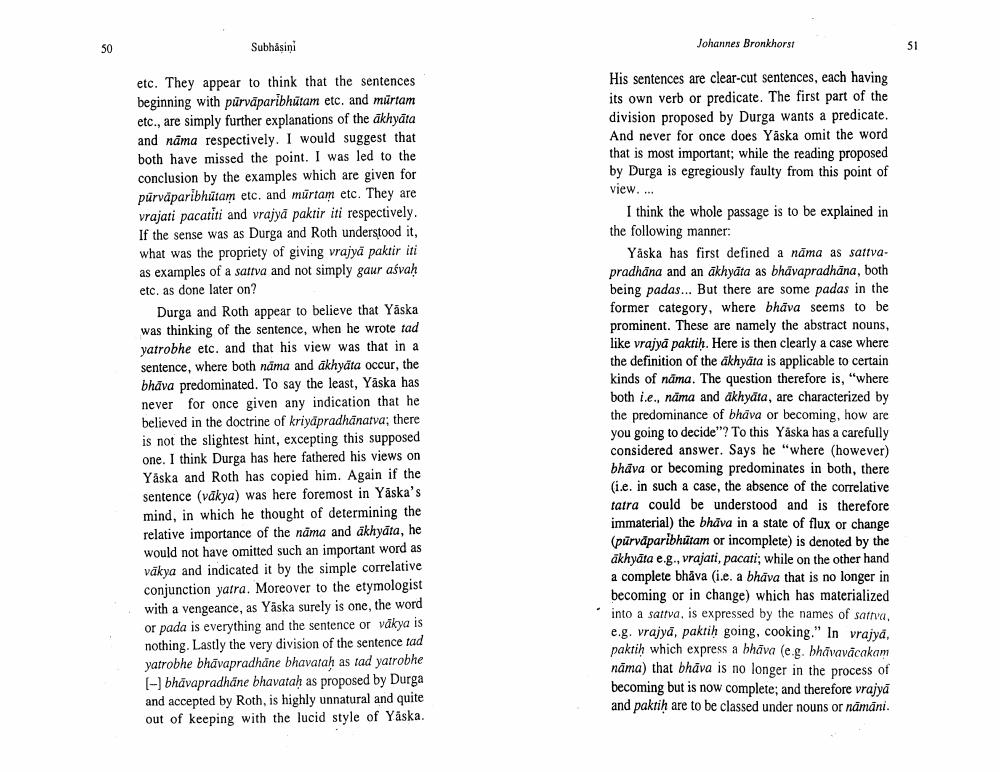Book Title: Yaska And Sentence Beginning Ofsabdabodha Author(s): Johannes Bronkhorst Publisher: Johannes Bronkhorst View full book textPage 4
________________ Subhasini Johannes Bronkhorst etc. They appear to think that the sentences beginning with pūrvaparibhūtam etc. and murtam etc., are simply further explanations of the ākhyāta and nāma respectively. I would suggest that both have missed the point. I was led to the conclusion by the examples which are given for purvaparibhūtam etc, and murtam etc. They are vrajati pacatiti and vrajyā paktir iti respectively. If the sense was as Durga and Roth understood it, what was the propriety of giving vrajya paktir iti as examples of a sativa and not simply gaur asvah etc. as done later on? Durga and Roth appear to believe that Yaska was thinking of the sentence, when he wrote tad yatrobhe etc. and that his view was that in a sentence, where both nama and akhyöta occur, the bhava predominated. To say the least, Yaska has never for once given any indication that he believed in the doctrine of kriyapradhanarva: there is not the slightest hint, excepting this supposed one. I think Durga has here fathered his views on Yaska and Roth has copied him. Again if the sentence (vākya) was here foremost in Yaska's mind, in which he thought of determining the relative importance of the nama and akhyāta, he would not have omitted such an important word as väkya and indicated it by the simple correlative conjunction yatra. Moreover to the etymologist with a vengeance, as Yaska surely is one, the word or pada is everything and the sentence or vakya is nothing. Lastly the very division of the sentence tad yatrobhe bhāvapradhane bhavatah as tad yatrobhe (-) bhāvapradhäne bhavatah as proposed by Durga and accepted by Roth, is highly unnatural and quite out of keeping with the lucid style of Yåska. His sentences are clear-cut sentences, each having its own verb or predicate. The first part of the division proposed by Durga wants a predicate. And never for once does Yäska omit the word that is most important; while the reading proposed by Durga is egregiously faulty from this point of view.... I think the whole passage is to be explained in the following manner: Yaska has first defined a nāma as sattvapradhana and an ākhyāta as bhavapradhana, both being padas... But there are some padas in the former category, where bhāva seems to be prominent. These are namely the abstract nouns, like vrajya paktih. Here is then clearly a case where the definition of the akhyata is applicable to certain kinds of nama. The question therefore is, "where both le., nama and akhyata, are characterized by the predominance of bhava or becoming, how are you going to decide"? To this Yåska has a carefully considered answer. Says he "where (however) bhava or becoming predominates in both, there (i.e. in such a case, the absence of the correlative tatra could be understood and is therefore immaterial) the bhāva in a state of flux or change (pūrvdparibhutam or incomplete) is denoted by the akhyata e.g., vrajari, pacati; while on the other hand a complete bhāva (i.e. a bhäva that is no longer in becoming or in change) which has materialized into a sattva, is expressed by the names of sata. e.g. vrajya, paktih going, cooking." In vrajya, paktih which express a bhāva (eg, bhāvavácakam nāma) that bhāva is no longer in the process of becoming but is now complete; and therefore vrajya and paktih are to be classed under nouns or nämāni.Page Navigation
1 2 3 4 5 6 7 8 9 10
